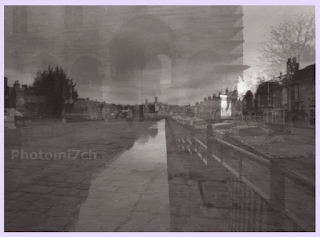As I write this, the log fire is blazing but it still feels cold. Outside the wind is howling, throwing rain against the windows like small stones, and distracting me from writing this article. The part of the article’s title is wrong in that the 120 format film contained in the black tubes is really Rollei Retro 400s.
I have used the film once before - so long ago that I cannot remember if I liked the results, nor even which developer I used. Now the rolls of film that are left are passed their best before date, by about two years. The film has traveled a lot in my camera bag, waiting for a set of circumstances which would allow me to use this fast film to its best effect.
I was at a location that I may not return to and the weather was not playing ball, with long, dull, overcast days. It would be a challenge to produce any images without the sun casting a shadow, but I was not going to be deterred.
The hand held light meter was telling me F 1.4 @ 125 the sec for my usual 100 ISO film, which was well below my Bronica SQAi F 2.8 lens. As I looked into my camera bag, there it was waiting - three rolls of Agfa 400s. Brilliant! Finally it would be used on a worthwhile project, instead of being used for the sake of it.
As I was loading the film into the camera, my mind had already wandered off to which film developer I was going to use and which paper to print with. I have been using Kodak’s HC 110 a lot and thought it would be a good idea to continue with it to enhance the contrast and reduce grain on the negatives.
Before you ask why I didn’t use a tripod, the simple answer is the terrain was very difficult to navigate and to use one would have been more of hazard than an asset. Needless to say that the time making images slipped by unnoticed, as did the changes of film backs. There was an ongoing question mark over the whole proceedings and whether or not it was a good choice of film.
Back in the darkroom, I checked out the dilution and time needed for the 400s in HC 110. I was surprised to see it was dilution B (1+31) for 6.5 minutes - the same as delta 100, apart from the extra half minute. I had a nagging doubt at the back of my mind as to whether it would be sufficient time.
With the diluted developer in the graduate and the thermometer reading 20C, I poured the chemical into the tank and proceeded with my standard processing method. When I removed the lid to pour out the developer, I noticed a lot of bubbles in the top, so alarm bells started ringing. The last time this happened, I ended up with a set of mottled negatives. Fifteen minutes later I was rinsing the developed negatives, regardless.
After dismounting the film from the spiral into the tank full of water, I pulled it out and between my fingers to get the excess water off, only to be presented with some very thin looking negatives. I was not pleased with myself for dismissing my doubts about timings. The upside was that the negatives looked to be very contrasty compared to the very overcast and flat day when they had been made.
I did increase the development time for the second and third films. It did make a difference, but not as much as I would have liked. Another downside of this film is its server curl. It was going to be interesting getting a contact print. Having studied the negatives in their sleeves, they look to be the thinnest I have ever produced. Printing will confirm whether this is the case. The other issue is that one set of negatives looks mottled.
The paper choice would be determined by the level of contrast the negatives produced. Normally I would not make pictures on dull, overcast days as I do not like low contrast light and the grey, washed out look that can result. However, on this occasion I had no choice, as I was at a location that inspired me with image ideas and despite the days being overcast, I doubted I would get a chance to return in better weather.
All the images were scanned from photographs






















































